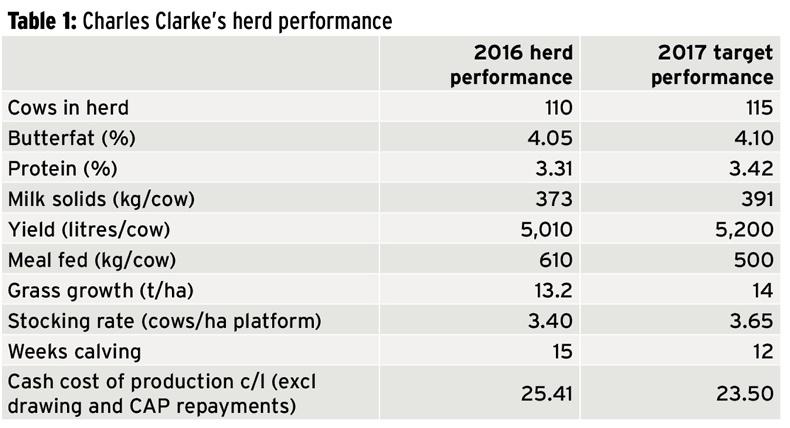Milk solids and herd fertility are both key performance indicators for Charles Clarke, Bailieborough, Co Cavan.
The farm has a grazing block of 32ha and is considered the most critical resource on the farm – maximising its performance in terms of grass growth and stocking rate ultimately determines profitability on this farm.
The predominant cow type on the farm is moving towards a Jersey-cross from the existing black and white Friesian cow. The main rationale for this approach is to increase milk solids relatively fast with hybrid vigour from cross-breeding.
The key limiting resource on this business is labour – Charles is a one-man operation, with additional help hired in only for peak periods.

More milk solids per hectare
He needs a low-maintenance and easily-managed cow for the system. The Jersey crossbred cow will bring more milk solids per hectare (MS/ha), is lighter and easier to manage at the shoulders of the grazing season when ground conditions are wet and difficult to manage on this Cavan farm.
The down side of this approach is lower cull cow values and somewhat lower calf sales, but this is not enough to change the profit calculation. Charles hasn’t culled any crossbred cows yet and calves from these cows may be slightly smaller, but generally bull calf sales have not been significantly reduced yet. From Charles’s viewpoint, he is not breeding to maximise cull cow or bull calf value on the farm.
Stocking rate on the platform has increased from 3.40 cows/ha to 3.65 cows/ha. Based on projected milk solids, this will take total MS/ha to 1,400kg. Charles has a large proportion of outside land for replacements and silage.
Higher protein is already beginning to flow, with the herd currently producing 1.85kg solids/cow/day. So a combination of higher protein, coupled with the higher stocking rate on the platform, is projected to deliver 150kg MS/ha more for 2017.
Maximising growth
Maximising growth on this farm is key. Weather conditions play a major role in grass growth, but soil fertility must be correct in order to capitalise on the growth.
Soil analysis in 2015 revealed significant shortfalls for key nutrients on the farm, with only 14% of the grazing block optimal for grass growth based on soil pH, phosphorus and potash.
Based on 2017 soil analysis, soil fertility has improved, with 70% of the grazing block now optimal for grass growth. This is filtering through to increase average grass growth on the farm. Last year, this platform had an average growth of 13.2t DM/ha.
Charles Clarke Bailieborough, Co Cavan
So far this year, grass growth is behind schedule on this farm. My stocking rate is higher this year, with more cows on the platform pushing stocking rate to 3.65cow/ha.
Very few bales have been taken off the platform to date. However, I have skipped three paddocks which will go for silage this week if weather allows. With these three paddocks out, stocking rate is at 4.2 cows/ha. Ultimately these paddocks are needed back in the platform as soon as possible to help lift the cover per cow.
Up to the weekend just past, we have been missing many of the heavy rain showers, which has held back growth on the farm. Thankfully, we got rain over the weekend, which will help push growth up to around 100kg/day.
I have two paddocks which need to be reseeded close to the parlour. If grass growth pushes on this week, I will spray these paddocks and get the reseed done.
Better soil fertility, coupled with the reseeds last year, is helping. Over the past two years, 150t of lime has been spread. On the grazing block, I am using compound fertiliser 18:6:12 or 24:2.5:10.
Breeding started this year on 4 May for the cows and 6 May for the heifers. This year, I have 45 replacement heifers, 42 of which went for AI service, and I am using a teaser bull with paint ball to help with heat detection, along with tail patches. A Jersey sire (OKT) was used on Friesian heifers and SEW has been used on crossbred heifers.
The pre-breeding work on the main milking herd, which involved identifying non-cycling cows three weeks before breeding started, has helped early submission rates. In the first three weeks of breeding, 81% of the herd was inseminated. Currently, we are 32 days into breeding, with eight cows out of the 118 not served as yet. The 45 heifers are more than I need for next year, but they have better genetics for milk solids and fertility, so I plan to bring them all into the herd.






SHARING OPTIONS